Introduction
Human resource management is very important in an organization for the proper management of human resources in an organization. It is basically carried to maximize the performance of employees to carry out the goals and objectives of the company. It focuses on recruitment, management and gives direction to people who are working for an organization (Thompson, 2011). This report is based on the topic of Human Resource Management of a leading firm in Canary Wharf. A human resource assistant is being appointed by a company for the setting up of different HR activities in the organization. An analytical report will be made which will help in providing a contribution to the HR department so that a firm can maintain a competitive advantage. With the help of this report scope, purpose, and key elements of human resource management will be analyzed. Internal and external factors by which human resource management gets affected in making decisions which also includes employee legislation will be examined in the report.
Task 1
P1 Purpose and functions of HRM which is applicable to the workforce planning
Human Resource Management can be defined as that management field which is concerned with planning, controlling, organizing different functions related to operations of the business which involves developing, procuring, utilizing and maintaining the workforce so as to achieve business objectives for the company economically and efficiently (Ployhart and Moliterno, 2011). HRM is applicable in the management of personnel, in employee welfare and also in maintaining an industrial relationship. Department of HR also practices strategic management which makes sure that all objectives are in alignment with vision, mission, objectives, and goals.
Strategic human resource management is concerned with developing, attracting, retaining and rewarding employees for an organisation as well as for employees benefit. Strategic HRM plays the main role in the success of an organisation, it utilizes opportunity and talent within the HR department so as to make other departments effective and strong. As an HR assistant of Canary Wharf, I have analyzed that there are soft and hard approaches to HRM which is used in planning and resourcing in the company (Crook and et.al., 2011 ). In hard HRM employees are simply treated as the business resource, it has a link with strong business planning. In this there is minimal communication among departments, less empowerment, appraisal is about judging staff and there is tall organisational structure. In soft HRM employees are treated as an important business resource. It is concerned with the focus on strategies and long term workforce planning, strong communication, competitive pay structure and flat organization structure (Kehoe and Wright, 2013).
There are various functions and purpose of HRM which is applicable in the planning and resourcing of the workforce in the mentioned company. The main purpose of HRM is to hire, develop and train employees whenever necessary. Several functions of HRM are:-
- Recruitment: HRM helps in recruiting the best for the firm. They advertise about a particular job, source candidates from different areas, screen applicants, do preliminary interviews and coordinate with managers regarding hiring, who are responsible for making a final decision.
- Safety: It is an important factor. Under the Occupational Safety and Health Act 1970, employers are responsible for providing safety at the workplace. It is the main function of HR to support in the safety of the workplace by maintaining logs for workplace injury and report regarding fatality.
- Employee relations: It is very necessary to maintain a relationship between employee and labor. Employee relation is the discipline of HR, which is concerned with strengthening the employer and employee relation by job satisfaction, solving conflicts and employee engagement (Abbour and et.al., 2013).
- Compensation and benefit: This HR function is handled by HR specialist with double expertise. In this structure of compensation and competitive pay, practices are being evaluated by HR.
- Training and Development: Proper training and development should be provided to employees. Department of HR also provides professional development and leadership training. Various programs are also done by HR for training and development.
P2 Strengths and weakness of recruitment and selection approaches
Recruitment is the very first step of the process to fill or examine a vacancy, for the sourcing of suitable candidates and for attracting applications and making contact. Selection is the next step in the assessment of candidates through different means and to make a choice which is followed by employment's offer (Choi, 2011). It means the identification of the right person for the right job. Systematic approaches to recruitment and selection are:
- Job description: It includes detailed information on all aspects of the job, which includes pay range, reporting requirement, job tasks, supervisory responsibility. It helps candidates to generate more interest in a job.
- Skills inventory: For finding an ideal candidate, a compilation of list which represents the ideal set of skills for an employee will help the organisation in recruitment and selection (Bloom and Van Reenen, 2011).
- Job posting strategy: It is a part of the appropriate selection and recruitment process to develop a strategy for posting jobs.
- Multi-step recruitment: A systematic recruitment process is necessary which provides deep insight into the interested candidates who meet specified skills for a job.
There are various advantages and disadvantages of the recruitment and selection approach. As an HR assistant, I have analyzed that the company follows an interview method which is easy and suitable for the selection of a candidate, it develops a relationship, collects primary and sufficient information, it is flexible, time-saving and less costly. It also has various disadvantages like it is an incomplete process, time-consuming, inefficient, provides no record and may sometime disappoint the interviewee (Alfes and et.al., 2013). A company recruits in two ways first is internal recruitment, it is when the business fills the vacancy within its organization with the existing workforce and external recruitment, it is when the vacancy is filled from a suitable and desired applicant who is outside the business.
Internal Recruitment
Advantages
- It is cheap and quick
- People are familiar and with the operations and business
- It is within the business so it provides an opportunity for promotion
- Strength and weakness of candidates are already known to the company
Disadvantages
- Limits the applicants
- No new idea can be introduced from outside
- Creation of another vacancy which should be fulfilled
Examples: There are various examples by which internal recruitment takes [place in a company, these examples are transfers, promotions, sources and recommendations from present employees. These methods will be helpful for HR in order to practice internal recruitment.
External Recruitment
Advantages
- New ideas from outside people
- A larger number of applications from which best will be selected
- People will have a wide range of experience
Disadvantages
- Long process
- More expensive because of advertisements and interviews (Renwick, Redman and Maguire, 2013).
- Process of selection may not be effective for revealing the best candidate
Examples: There are different examples of external recruitment which the company follows in order to recruit the desired candidates. These are advertisements, employment exchanges, campus placements, recommendations from old employees who are working in a company and labor unions. Get essay help from experts in usa
Task 2
P3 Benefits of HRM practices for employer and employee
Human resource management includes practices that are used by the managers and HR and organization to manage people. HRM practices include learning and development, workforce design, employee benefits, and flexible organization.
- Learning and development: The strategy of learning and development is aligned with business needs. It is the main practice of HRM and it is very common in the large firms. Various trends have been used in learning and development which includes on the job training, in house methods, coaching, E-learning courses, conferences, workshops, etc. Learning and development are very necessary for an organization for the effective and efficient development of employees in an organization (Jiang, Lepak, and Baer, 2012).
- Workforce design: Another important HRM practice is workforce design. It is very necessary to give directions and design jobs according to the workforce in the organisation. Structuring of an organization is also done on the basis of employees and employers in the organization.
- Employee benefits: HR department is concerned with the benefits of employees so as to motivate them by increasing their efficiency and effectiveness towards work. Managers are responsible for maximizing employee's performance.
- Flexible organization: It is necessary to provide a flexible workplace to the employees so as to retain them. HRM is responsible for providing flexible organization, flexible design of work, work schedules, the composition of teams related to work and communication formats (Guest, 2011).
These HRM practices have several benefits for the company and employee.
|
Benefits for the company |
Benefits for employee |
|
It helps in promoting positive behavior within the organization. |
Different HRM practices develop, satisfy and encourage employees. |
|
It helps in building a flexible environment or workplace (Daley, 2012). |
It helps in resolving conflicts among employees in the organization. |
|
The company provides training and development, so time is not wasted and helps the company to secure employees for a long time. |
HRM practices help employees to maintain a relationship with the organization and other employees. |
|
It helps the company in making several important decisions. |
It serves as an information resource for employees. |
P4 Evaluation of the effectiveness of HRM practice
HRM practices are very helpful for increasing productivity and profit in the organization. They are practiced continuously in an organization with full effectiveness, which helps in the growth and success of a company (Guest, 2011). As an HR assistant, I have analyzed that there are various things by which the effectiveness of HRM can be analyzed in the organization.
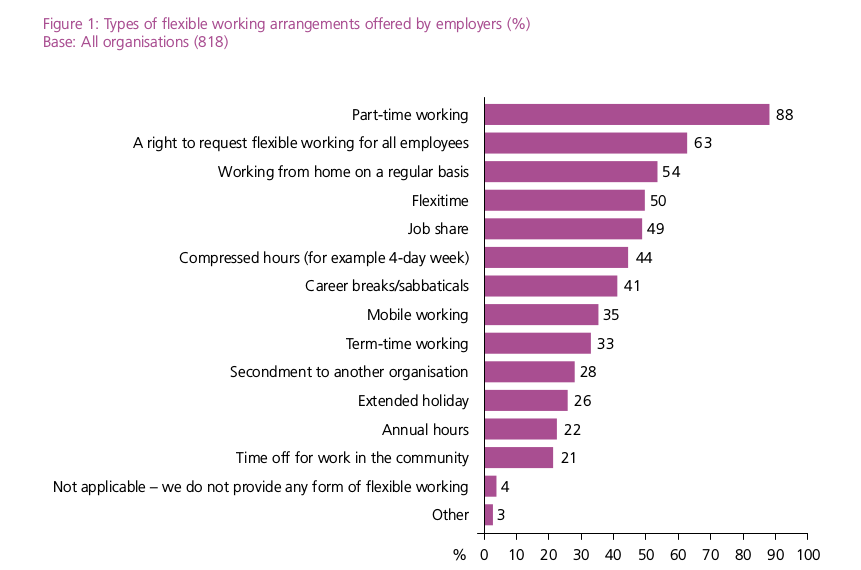
Flexible working arrangements: It has been analyzed from the graph that 88 % of people think that part-time working is the most flexible working arrangements.
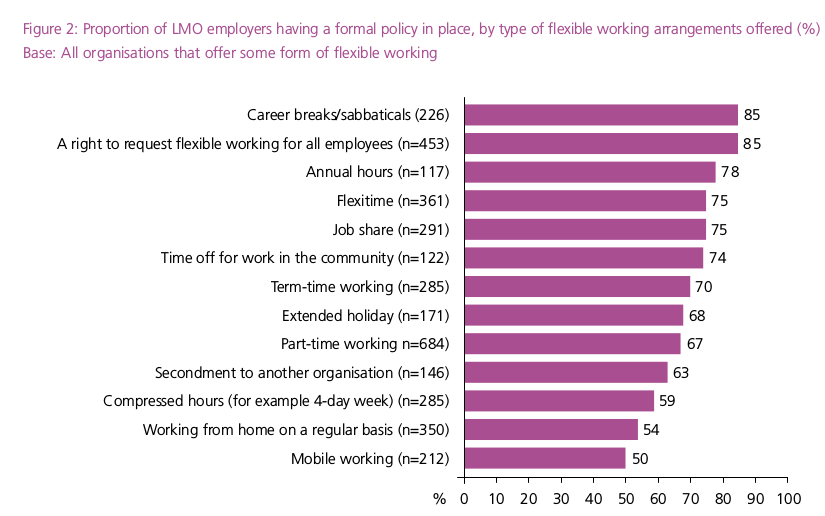
The proportion of LMO employees: It has been analyzed from the graph that 85 % think that the main proportion of LMO employees of formal policy is career breaks.
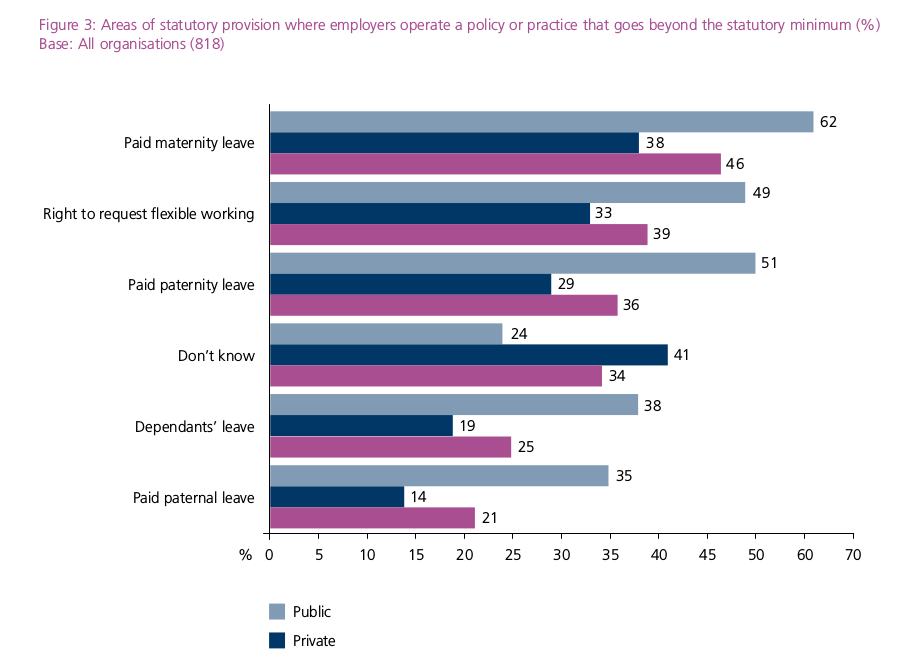
Areas of statutory provision: 62% think that the main area of a statutory provision is paid maternity leaves.
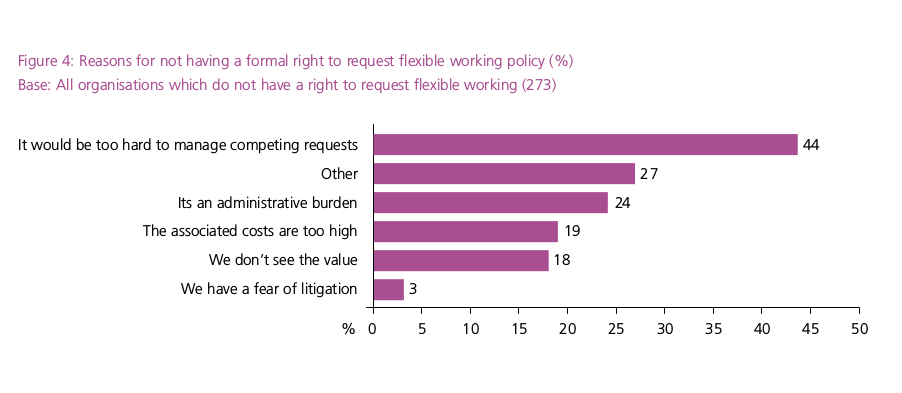
Reasons for not having formal request rights: 44 % of employees think that they will be too hard to manage to compete for requests.
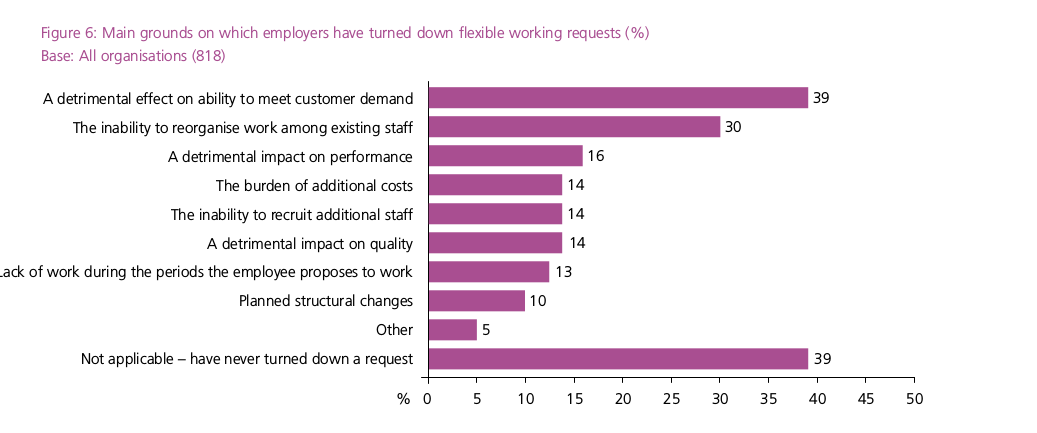
The main reason for turning down a flexible working request: 39% think there will be a determined effect to meet the demand of customers.
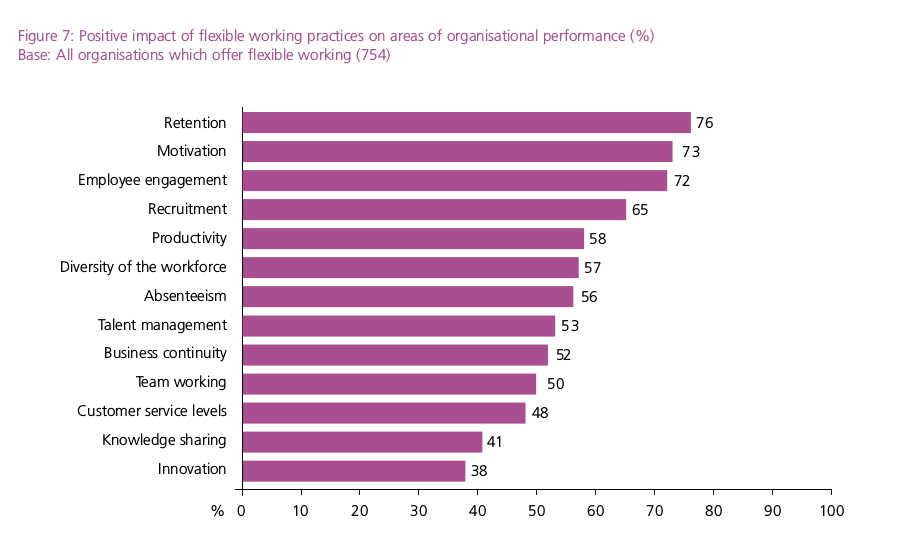
Retention: It is shown that there is a positive effect on employee retention because of flexible working practices in an organization.
Task 3
P5 Importance of employee relation to influencing HRM decision making
As an HR assistant of a firm in Canary Wharf, it has been analyzed that employee relation plays a significant role in decision making, which helps the HRM and organization to take more effective and efficient decisions. HRM involves the management of employees in the organization, and take various important decisions (Buller and McEvoy, 2012). So it needs the involvement of employees in taking such decisions so as to execute them properly according to the employees. Employee relation is defined as the relationship between the employee and employer so as to establish employment conditions.
Also Check: Online Assignment Writing Service
It involves the interaction level between employee and employer, representatives for achieving the set of working conditions that will help in meeting employee's needs and also allows the organization to achieve tactical, strategic and operational objectives. It is important that employees should share healthy relations in the workplace. Employee relation is important for taking HRM decisions, several importance is:
- There are a number of issues that a single person cannot solve and cannot take decisions alone. In such cases, the HRM department needs guidance and advice from employees in taking decisions. It sometimes helps in giving brilliant idea which will help in achieving targets (Lengnick-Hall and Beck, 2011).
- It is easy to perform work effectively if it is being shared among all. A healthy employee relation will help in sharing work with fellow employees. In this way, responsibilities can be divided among various team members to perform the assigned tasks.
- With the proper involvement of employees, human resource management will be able to make an organization a good and happy place to work. An individual person may sometimes lose concentration or focus and can take stress and tensions, so if there will be a healthy environment with good employee relations, employees will also remain motivated and it will in taking good HRM decisions (Purce, 2014).
- Good employee relation helps in decreasing conflicts and disputes among employees in an organization. People in such organizations adjust more and don't find fault in each other, rather they concentrate on work more and perform better. Employees treat each other as friends and try best to compromise which makes everyone happy and satisfied.
- If there will be good employee relations, the individuals will feel motivated and it will help the human resource management department in practicing better management. Employees will feel confident and secure and therefore will deliver the best.
- Employee relation helps in reducing employee absenteeism at the workplace. People will be more serious in working and will come to the office daily. They will enjoy their work and will not take leaves (Huselid and Becker, 2011).
- Employee relations will help HRM in solving various problems within the organization by taking better and effective ideas from employees.
P6 Key elements of employment legislation and its impact on HRM decision making
There is various employee legislation that impacts the decision making of human resource management. The several acts will help in giving directions which will eventually help in the effective decisions making by the HRM. A body of law has developed employee/employer relations and several employer and employee rights in the workplace. These includes:
- The Employment Rights Act: It is the most important activities and it includes the entitlement of pay statement and national minimum wage. It also includes that the working terms and conditions should be there in written which helps HRM in providing proper job description (Wright and McMahan, 2011).
- The Sex Discrimination Act, 1975: It helps in protecting employees against discrimination on the basis of gender in a job advertisement, in the selection of employees, in employee promotion and in offering training and development opportunities.
- The Equal Pay Act, 1970: It describes that the man and women should receive equal pay for doing equal work in the organization (Sparrow, Brewster and Chung, 2016).
- The Race Relations Act, 1976: This act defines that there should be no discrimination on the basis of caste, sex, religion, gender, etc.
- The Disability Discrimination Act, 1995: This act is applied to an organization that has more than 20 people. It is necessary for them to accommodate disabled needs and should establish a right of access in education, transport and other areas for the person who is disabled. This act also defines discrimination in the relation of disability, when disabled is not treated equally.
- The National Minimum Wage Act, 1998: Every employee is liable to get minimum wage in the organization. The minimum wage should be increased each year to maintain the cost of living (Berman and et.al., 2012).
- The Employment Relations Act, 1999: This act sets out that trade unions should be recognized by the employers where 40% are eligible to do so and majority voting is in favor of union recognition. It also describes that the organization should maintain a healthy relationship among employers and organizations for effective working for achieving goals and objectives.
- The Working Time Directive, 1999: It is guaranteed that all employees maximum of 48 hours of the working week and four weeks of holiday. Employees can choose to work late according to their wishes.
Task 4
P7 Applications of HRM practice in relation to work
Human resource management practices are very important in an organization for efficient and effective work management in the organization. It helps in taking various important decisions that will help in the success and growth of the business. It also helps with performance management and evaluation (Storey, 2014). HRM plays a vital role in any organization which will be helpful in company reputation building. As an HR assistant, I have analyzed that HRM is the factor for the attainment of growth. HRM practice includes training and development, planning, recruiting, selection, career management, performance evaluation, rewards and many more.
HRM practices help in the planning and designing of various jobs in the organization. With the help of this the organization plan various activities and programs (Berman and et.al., 2012). HRM deals with the various issues related to the day to day activities in the organization. It includes activities related to compensation, organization development, safety, performance management, wellness, benefits, training, employee motivation, etc. It plays a strategic role in the management of people in the organization and maintenance of environment and culture. Nursing students looking for dissertation help must try out our Nursing Dissertation Help UK services from experts.
HRM is responsible for the recruitment of a superior workforce. It helps in providing leadership, training, monitoring selection and many more (Bratton and Gold, 2012). It helps in recommending market-based salaries and develop strategies for various plans. It helps in implementing employee benefit programs that retain and attract employees in the organization. HR is responsible for the control of cost and takes various options. It also provides training and development to the workforce in an organization through which the development of employees is being done which helps them to perform effectively in the organization. Team building opportunities are also created in an organization.
Students also look for Term Paper Help.
HRM is continuously practiced in an organization, which helps in the administration of employees properly and perfectly. Management of human resources also involves the performance management and evaluation of employees in an organization (Boxall and Purcell, 2011). With the help of effective human resource management, employee's performance is being evaluated in the organization and then on the basis of that various benefits are being given to them.
Example: Job description of nurse and interview questions
Chosen hospital for this is University Hospital Southampton NHS, who are looking for the Nurse and for this job description has been prepared.
|
Job Description
|
|
1. Job Details Job Title: Staff Nurse Responsible to: Senior Nurse Department and Base: Ha wick community/ University Hospital Southampton NHS |
|
2. Job Purpose To perform actions in a team. To contribute to delivering high-quality care of nursing. To take charge of the ward, To provide nursing coverage to minor injury unit, treatment room. |
|
3. Main responsibilities and duties · Assessing nursing needs, implement, develop and evaluate the care of nursing. · To carry out relevant care forms with supervision. · To give advice on health and illness prevention. · To ensure nursing procedures are carried accordingly. · Maintenance of records as per guidelines. · Help junior staff, students with managerial skills by teaching and assessing. |
Interview questions:
- Why you choose nursing as a career?
- How your training helps you in preparing a nursing career?
- How do you deal with rude doctors?
- How you handle stress on the job?
- How will you handle a family who is not happy with your patient's care?
Conclusion
It is analyzed from the report that human resource management is the key factor of the organization for achieving growth and success. As an HR assistant, I have examined various things related to HRM which will support the HR department in taking several decisions. From the above case study, it can be concluded that the HRM practice helps the firm in leading successfully. It helps in workforce planning and decision making, and it is beneficial for employees, employers, and organizations. Various HRM legislation should also be practiced by the company for the effective workforce and also for maintaining safety at the workplace. It is defined that the practices of HRM are very helpful for an organization.
Related Service: Case Study Writing Service
References
- Albrech, S.L., 2011. Handbook of employee engagement: Perspectives, issues, research, and practice. Human Resource Management International Digest.
- Alfes and et.al., 2013. The link between perceived human resource management practices, engagement and employee behavior: a moderated mediation model. The international journal of human resource management.
- Armstrong, M. and Taylor, S., 2014. Armstrong's handbook of human resource management practice. Kogan Page Publishers.
- Berman and et.al., 2012. Human resource management in public service: Paradoxes, processes, and problems. Sage.
- Bloom, N. and Van Reenen, J., 2011. Human resource management and productivity. Handbook of labor economics.



















